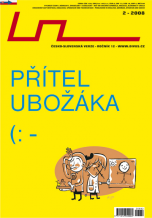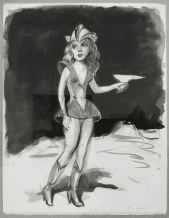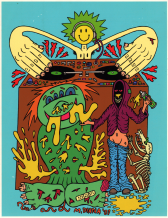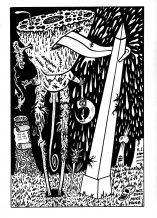| Revista Umělec 2002/2 >> In the Course of Time | Lista de todas las ediciones | ||||||||||||
|
|||||||||||||
In the Course of TimeRevista Umělec 2002/201.02.2002 Karel Císař | Perfil | en cs |
|||||||||||||
|
The video work of young British artist Steve McQueen was recently exhibited at a solo art exhibition in the Kunsthalle Vienna and at Documenta 11 in Kassel. To better understand his work it might be helpful to examine a comment he made in an interview for Art Monthly back in 1996.
When editor Patricia Bickers asked him what significance film framing might have to his work, he commented that the road movie was for him an ideal representation of the flow of time and was thus the foundation for quality film media.1 He specifically mentioned Wim Wenders’ Alice in den Städten (Alice in the Cities), also mentioned by Gilles Deleuze in a similar context: “The mobile camera is like a general equivalent of all the means of local transportation that it shows or that it makes use of — the airplane, car, ship, bicycle, walking, subway. Wenders was to make this equivalence the soul of two of his films, Im Lauf der Zeit (Kings of the Road) and Alice in den Städten (Alice in the Cities), thus introducing into cinema a particularly concrete reflection on the cinema. In other words, the essence of the cinematographical movement-image lies in extracting from vehicles or moving bodies the movement which is their common substance or extracting from moving bodies the mobility which is their essence.”2 Perhaps the most convincing work in this respect is McQueen’s triple projection Drumroll (1998). This video is an uncut recording of 57th Street and 5th Avenue in New York from three cameras lashed inside a barrel, all three aiming in different directions as the artist rolls it past the luxury shops and his home gallery, Marian Goodman. The recording offers a complex, indiscriminate picture of a given exterior, which is necessarily deprived of any subjective interference. At the same time, the triple-projection accentuates the revolving movements of the barrel as the source of energy that sets the cameras in motion. The counterclockwise revolving image on the left side of the monumental video projection, which looks like the spinning drum of an automatic clothes washer, captures pedestrians as they stroll along the sidewalk and shop windows. On the right we see, in an image spinning in the opposite direction, one midtown New York street — ubiquitous yellow cabs included. The vertically spinning camera in the middle periodically captures the sidewalk, sky and then the black face of the artist as he rolls the barrel. The soundtrack, which McQueen uses for the first time, is an important element of this work. It is precisely the sound and the character of the spinning images that identifies the otherwise invisible object in which the cameras are imbedded.3 Sound plays an even more important role in one of the artist’s last two films. Both were produced by the London group Artangel and were made for Documenta 11, whose curator, Okwui Enwezor, also produced both films. It is only thanks to the rattling soundtrack in Western Deep, an 8mm film transferred to DVD, that we can guess what is happening in front of us, or perhaps what we are participating in. Speculating from the image, which is in darkness except for the odd moments when a radiant fragment of a sweaty black body breaks through, we might suppose that we were watching a recording of a miner descending in an elevator into one of the deepest gold mines in South Africa — an image revealed in the very last scene of the video. Similar to the inhumanly complete, clockwork-perfect view in Drumroll, here, too, the movement of an otherwise nearly static camera is provided by attaching it to a moving object (an elevator cage). Another similarity is that the length of each film is determined by external factors. Drumroll has the barrel with the built-in cameras rolling down the block while Western Deep lasts as long as the time taken to descend a three-kilometer-deep mine. In his choice of shots, Steve McQueen takes his attempt to achieve a physical perception of his films to the extreme. If watching three spinning images for twenty-two minutes creates in the viewer intense nausea, not unlike seasickness, then the twenty-five-minute descent into the bowels of the earth will at the very least cause mild claustrophobia. However McQueen’s latest videos — the analyzed films Drumroll and Western Deep, as well as Carib’s Leap (a reconstruction of a mass suicide of the Caribbean Indians, which McQueen made in cooperation with Wenders’ cinematographer Robby Müller) — are not the only works to achieve a similar physical intensity and direct experience of time. His previous works — Girls Tricky (2001), Five Easy Pieces (1995), and Bear (1993) — also achieved similar effect. In these works the camera nearly gives up its own movement in order to emphasize the movement of what happening in front of the lens.4 In Girls Tricky he captures the frenetic movements of Adrian Thaws, a.k.a. Tricky, as he was recording a composition for Blow Back, one of his recent albums. In Five Easy Pieces he films a gyrating hoola-hop, and in the film Bear the emotionally charged combat of two men. Although narrow-minded interpretations of his work — despite the artist’s protests — have dubbed it as being the work of political difference,5 his main interest is elsewhere. Rather than working with themes dealing with political questions, he prefers to make inquiries into the mutual relationships of body, time, and movement and their possible interpretation in film. His deeply abstracted works attest to this and is especially true of his slide projection Current, in which the individual images, showing the rippling surface of a river with a bicycle at the bottom, blend into one another. “I like to make films in which people have the feeling that they could almost take sand in hands and rub it in their palms. Yet at the same time I also want film to be like a piece of wet soap, which slips out of your grip. You have to physically move and adjust your position in relation to the film so that the film directs you and not vice versa.”6 1. Let’s Get Physical, Steve McQueen, interviewed by Patricia Bickers, Art Monthly Dec. 96–Jan. 97, No. 202, p. 3. 2. G. Deleuze, Cinema 1: The Movement-Image, National Film Archive, Prague 2000, p. 34. 3. See Doris Krystof, The Song of the Street. “Drumroll” as an Artistic Manifesto, Steve McQueen, Kunsthalle Wien 2001, pp. 21–36. Steve McQueen himself emphasized the musical aspect of his work when in an interview with his curator from the Vienna exhibition, Gerald Matt, he pointed out that while working he almost felt like a musician, for his one task while rolling the barrel, in his own words, was to “keep up the rhythm.” See Steve McQueen in conversation with Gerald Matt, ibid., p. 16. 4. See Jon Thomson, “It’s the Way you Tell’em”. Narrative Cliché in the Films of Steve McQueen, in: Steve McQueen, Stedelijk Van Abbe-museum Eindhoven 1997, p. 5. 5. See Christian Haye, Motion Pictures, Frieze, May 1996, pp. 40–43. 6. Let’s Get Physical, Steve McQueen interviewed by Patricia Bickers, Art Monthly Dec. 96–Jan. 97, No. 202, p. 5. Drumroll, 1998, color video projection, triptych, sound, 22’01 min. Bear, 1993, 16 mm black and white film, video transfer, silent, 10’35 min. Girls Tricky, 2001, color video projection, sound, 14’47 min. Current, 1999, color slide back projection Western Deep, 2002, film, 8 mm transferred to video, color, sound, 25 min.
01.02.2002
Artículos recomendados
|
|||||||||||||
|
04.02.2020 10:17
Letošní 50. ročník Art Basel přilákal celkem 93 000 návštěvníků a sběratelů z 80 zemí světa. 290 prémiových galerií představilo umělecká díla od počátku 20. století až po současnost. Hlavní sektor přehlídky, tradičně v prvním patře výstavního prostoru, představil 232 předních galerií z celého světa nabízející umění nejvyšší kvality. Veletrh ukázal vzestupný trend prodeje prostřednictvím galerií jak soukromým sbírkám, tak i institucím. Kromě hlavního veletrhu stály za návštěvu i ty přidružené: Volta, Liste a Photo Basel, k tomu doprovodné programy a výstavy v místních institucích, které kvalitou daleko přesahují hranice města tj. Kunsthalle Basel, Kunstmuseum, Tinguely muzeum nebo Fondation Beyeler.
|



































 We Are Rising National Gallery For You! Go to Kyjov by Krásná Lípa no.37.
We Are Rising National Gallery For You! Go to Kyjov by Krásná Lípa no.37.
Comentarios
Actualmente no hay comentariosAgregar nuevo comentario